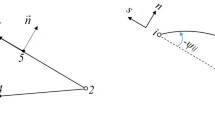Abstract
A family of new 4-noded membrane elements with drilling degrees of freedom and unsymmetric assumed stresses is presented; it is derived from a mixed variational principle originally formulated for finite strain analysis and already used in the literature to develop a purely kinematic membrane model. The performance of these elements, investigated through some well established benchmark problems, is found to be fairly good and their accuracy is comparable with that given by models with a larger number of nodal parameters.
Similar content being viewed by others
References
Allman, D. J. (1984): A compatible triangular element including vertex rotations for plane elasticity analysis. Comp. and Struct. 19, 1–8
Allman, D. J. (1988): A quadrilateral finite element including vertex rotations for plane elasticity analysis. Intern. J. Numer. Meth. Eng. 26, 717–730
Atluri, S. N. (1979): On rate principles for finite strain analysis of elastic and inelastic nonlinear solids. In: recent research on mechanical behaviour. pp 79–107, University of tokyo Press, Tokyo
Atluri, S. N. (1980): On some new general and complementary energy theorems for the rate problems in finite strain, classical elastoplasticity. J. Struct. Mech. 8, 61–92
Atluri, S. N. (1984): Alternate stress and conjugate strain measures, and mixed variational formulations involving rigid rotations, for computational analyses of finitely deformed solids, with application to plates and shells—I Theory. Comp. and Struct. 18, 98–116
Atluri, S. N.; Murakawa, H. (1977): On hybrid finite element models in nonlinear solid mechanics. In: Bergan, P. G. et al. (eds): finite elements in nonlinear mechanics. Tapir Press, Norway 1, 25–69
Bergan, P. G.; Felippa, C. A. (1985): A triangular membrane element with rotational degrees of freedom. Comp. Meth. Appl. Mech. Eng. 50, 25–69
Cook, R. D. (1974): Improved two dimensional finite elements. ASCE J. Struct. Div. ST 6, pp 1851–1863
Cook, R. D. (1981): Concepts and applications of finite element analysis. (2nd ed). Wiley: New York.
Cook, R. D. (1986): On the Allman triangle and a related quadrilateral element. Comp. and Struct. 22, 1065–1067
Cook, R. D. (1987): A plane hybrid element with rotational d.o.f. and adjustable stiffness. Intern. J. Numer. Meth. Eng. 24, 1499–1508
Fraeijs de Veubeke, B. M. (1975): Stress function approach. Proceedings of world congress of finite element methods in Structural Mechanics, Bournemouth, U.K., pp J1–J51
Fraeijs de Veubeke, B. M.; Millard, A. (1976): Discretization of the stress fields in the finite element method. em Journal of the Franklin Institute. 302, 389–412
Ibrahimbegovich, A.; Taylor, R. L.; Wilson, E. L. (1990): A robust quadrilateral membrane finite element with drilling degrees of freedom. Intern. J. Numer. Meth. Eng. 30 445–457
Iura, M.; Atluri, S. N. (1992): Formulation of a membrane finite element with drilling degrees of freedom. Comp. Mech. 9, 417–428
MacNeal, R. H.; Harder, R. L. (1988): A proposed standard set of problems to test finite element accuracy. Finite elements in analysis and design. 1, 3–20
MacNeal, R. H.; Harder, R. L. (1988): A refined four-noded membrane element with rotational degrees of freedom. Comp. and Struct. 28, 75–84
Murakawa, H. (1978): Incremental hybrid finite element methods for finite deformation problems (with special emphasis on complementary energy principle). Ph.D. Thesis, Georgia Institute of Technology
Murakawa, H.; Atluri, S. N. (1978): Finite elasticity solutions using hybrid finite elements based on a complementary energy principle. ASME J. Appl. Mech. 45, 539–547
Murakawa, H.; Atluri, S. N. (1979): Finite elasticity solutions using hybrid finite elements based on a complementary energy principle. Part 2: incompressible materials. ASME J. Appl. Mech. 46, 71–77
Pian, T. H. H. (1964): Derivation of element stiffness matrices by assumed stress distributions. AIAA J. 2, 1333–1336
Pian, T. H. H. (1985): Finite elements based on consistently assumed stresses and displacements. Finite Elements in analysis and Design 1, 131–140
Pian, T. H. H.; Chen, D. (1983): On the suppression of zero energy deformation modes. Intern. J. Numer. Meth. Eng. 19, 1741–1752
Pian, T. H. H.; Sumihara, K. (1984): Rational approach for assumed stress finite elements. Intern. J. Numer. Meth. Eng. 20, 1685–1695
Pian, T. H. H.; Tong, P. (1986): Relations between incompatible displacement model and hybrid stress model. Intern. J. Numer. Meth. Eng. 22, 173–181
Pian, T. H. H.; Wu, C.-C. (1988): A rational approach for choosing stress terms for hybrid finite element formulations Intern. J. Numer. Meth. Eng. 26, 2331–2343
Punch, E. F. (1983): Stable, invariant, least-order isoparametric mixed-hubrid stress elements: Linear elastic continua, and finitely deformed plates and shells. Ph.D. Thesis, Georgia Institute of Technology
Punch, E. F.; Atluri, S. N. (1984): Development and testing of stable, invariant, isoparametric curvilinear 2-and 3-D hybrid stress elements. Comp. Meth. Appl. Mech. Eng. 47, 331–356
Reissner, E. (1965): A note on variational principles in elasticity. Intern. J. Solids Struct. 1, 93–95
Rubinstein, R.; Punch, E. F.; Atluri, S. N. (1983): An analysis of, and remedies for, kinematic modes in hybrid-stress finite elements: selection of stable, invariant stress fields. comp. Meth. Appl. Mech. Eng. 38, 63–92
Wu, C.-C.; Huang, M.-G.; Pian, T. H. H. (1987). Consistency condition and convergence criteria of incompatible elements: general formulation of incompatible functions and its application. Comp. and Struct. 27, 639–644
Yunus, S. M. (1988): A study of different hybrid elements with and without rotational d.o.f. for plane stress/plane strain problems. Comp. and Struct. 30, 1127–1133
Yunus, S. M.; Saigal, S.; Cook, R. D. (1989): On improved hybrid finite elements with rotational degrees of freedom. Intern. J. Numer. Meth. Eng. 28, 785–800
Author information
Authors and Affiliations
Additional information
Communicated by S. N. Atluri, August 13, 1992
Rights and permissions
About this article
Cite this article
Cazzani, A., Atluri, S.N. Four-noded mixed finite elements, using unsymmetric stresses, for linear analysis of membranes. Computational Mechanics 11, 229–251 (1993). https://doi.org/10.1007/BF00371864
Issue Date:
DOI: https://doi.org/10.1007/BF00371864




